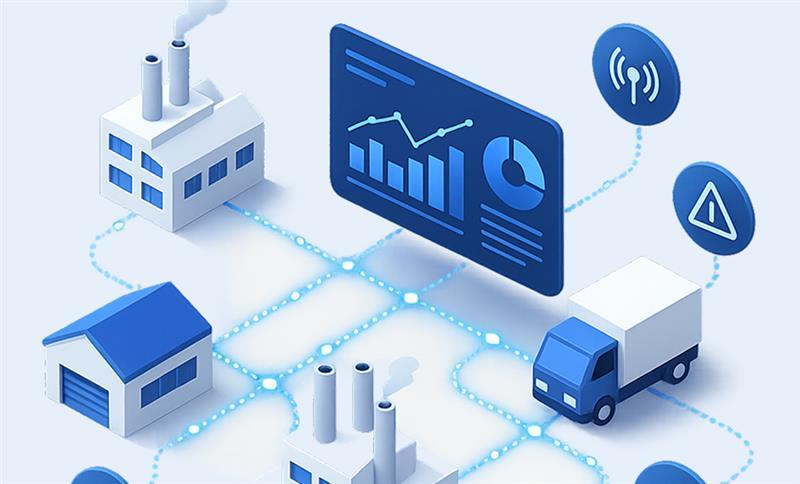Introduction
Having a complete view of inbound shipments is critical for chemical manufacturers. Maintaining accurate product counts, ensuring on-time delivery, monitoring rising transportation costs and complying with the Department of Transportation’s (DOT) regulations are some of the reasons.
As a highly regulated industry, chemical manufacturers are under constant compliance pressure at several levels, not just federal. A clear view of end-to-end supply chain visibility helps mitigate supply chain challenges.
For example, a single federal hazardous materials violation can cost your company anywhere from nearly $80,000 to $500,000.
Failing quality controls and product recalls come with steep costs. Adding competition, transportation, supply chain challenges, and growing customer expectations means chemical manufacturers can’t afford to make any mistakes.
One of the more manageable costs is freight. It can be expensive and daunting to manage when your organization makes hundreds of shipments daily.
Accurate labeling becomes critical in terms of understanding what is in each shipment. Labeling is also vital when planning the classification and storage of the materials, plus determining workforce requirements. Without a straightforward labeling method that all workers can use, ensuring end-to-end supply chain visibility becomes a nightmare.
Consequences of Poor Freight Management
Poor freight management can lead to several different problems, such as:
- Damaged, lost, or late deliveries
- Processing delays causing customer complaints
- Delays in downstream work orders
- Greater freight costs caused by carrier policies
- Wasted raw materials and space due to unaccounted inventory
- Decreased productivity due to poor scheduling
This list doesn’t account for accidents, either. What if hazardous materials get mixed up with another order? How will you know? Mistakes like this can be disastrous and even fatal.
One report states that unreported delays lead to an increase in inventory carrying costs, as high as 30-40% of total inventory costs.
Every stage of the chemical supply chain, from raw materials to end-user delivery, requires a significant amount of planning, tracking and implementation. Companies today need a centralized and secured solution that offers flexibility with the ability to integrate, automate, and be optimized regardless of location.
Enterprise labeling solutions boost efficiency, accuracy, and reliability, plus significant cost savings in these highly regulated environments.
Book a consultation to get a comprehensive freight visibility management solution.
Managing Hazardous Freight – Responsibility of the Manufacturer and Carrier

It’s the manufacturer’s responsibility for identifying hazardous materials, not the freight carrier’s. Whenever chemicals are being shipped, it’s up to the manufacturer to ensure its documentation, labeling and packaging all meet government standards.
Among the most common items on a hazardous materials manufacturer’s shipping checklist are ensuring all of the following items are current:
Hazardous Materials Manufacturer’s Shipping checklist
- Contents meet the federal definition of “Hazardous Material”
- Employees are properly trained
- Correct packaging is used
- Blocking and bracing requirements are outlined
- Shipping manifest is complete and accurate
- Emergency response information is included
- Emergency response contact information
- Certifications are complete
- Security plans and processes are in place
- Incident reporting procedures are being used
- Product Compatibility is accounted for when shipping multiple chemicals together
Among the correct documentation requirements are:
- Shipping name
- Classification/ Division
- Identification Number
- Hazard warning labels and markings
Freight carriers have their responsibilities, too. These include validating the following:
- Accuracy of the manufacturer’s packing lists.
- Products are accurately described and adequately packaged.
- Vehicle is suitable for shipping chemical products and is in good repair.
Carriers, as well, have additional responsibilities when transporting hazardous materials. These include:
- Documents and manifests are accurate and complete
- Proper labels and placards are in all required positions on the vehicle and the shipment
- Loading and unloading meets safety guidelines
- Employee training is complete
- Security plans and processes are up to date
- Incident reporting procedures are up to date
- Adequate blocking and bracing meets government guidelines
- Product compatibility is considered when shipping multiple chemicals together
The Real Cost of Freight
The actual cost of freight can only be realized after a product reaches its final destination. The final cost of deliveries can be influenced by a number of different fees for layovers, oversized cargo, after-hour deliveries, mispacked orders, incomplete manifests and damage incurred during shipping and unloading.
Large businesses making hundreds of shipments a day are often able to absorb shipping cost fluctuations that might severely hurt small and medium businesses. Unfortunately, manufacturers shipping products don’t always know what will trigger additional fees. These issues with inbound shipments can affect all departments in a supply chain: Sales, Planning, Purchasing, Production, Accounting, and possibly more.
Understanding your transportation process inside and out is the most effective solution to address supply chain challenges in the chemical industry. Staying on top of every process, every step of the way lets you track and monitor the movement and condition of products from start to finish. Lack of visibility into shipping is the most challenging thing to correct and can significantly impact both manufacturers and shipping companies.
55%
of Third Party Logistics suppliers (3PLs) said they either lost business or didn’t know if they lost business due to lack of visibility of their offerings.
Source: American Shipper
Outdated Systems
Even today, a surprisingly large number of companies continue to run their operations on antiquated inventory tracking systems designed to manage local-only supply chains. Successful supply chains operate globally, connecting production and procurement to sales and customer service. This way, everyone knows what’s in transit and when it’s due to arrive.
Maintaining freight visibility, especially for a company spread thin, is not an easy task. Obsolete, “legacy” systems make it an even more challenging objective.
A modern, cloud-based solution provides a complete end-to-end view of a supply chain network.
Switching operations to an integrated, multifunctional transportation management system (TMS) platform brings agility to your transportation network. This kind of switch offers better support for seamless communication, allowing companies to respond proactively to unexpected issues and customer demands.
Disparate Systems
Effective coordination and collaboration should be needed across multiple sites and warehouses to manage a supply chain effectively. Running a business on many different applications is one of the biggest roadblocks to total freight visibility. If your organization’s systems can’t connect with your vendors, there’s a good chance you’re missing something.
Having an inventory control system that communicates with your suppliers’ improves inventory management, communication and freight visibility. Connecting a Transportation Management System (TMS) with warehouse operations allows shippers to find detailed insights from inbound and outbound logistics within a single unified platform.
Lack of collaboration
Tracking shipments in real-time is the core of transportation management. When loads are distributed across different carriers, getting reliable data from the entire carrier network can be a real challenge. Trying to track shipping information manually leads to inaccurate quotes and customer complaints.
Combining business intelligence and advanced analytics offers real-time shipping and location data visibility. The data delivers accurate tracking information directly from the supplier’s carrier to the shipper. Your customer will always know when their products are due to arrive.
Finding the Right Solution
Most logistics solutions are unable to display “right now” data on incoming shipments and outgoing orders. If you’re in the process of figuring out what solution will be best for your business,there are a few questions you’ll want to be sure you ask:
- Does their system have AI-enabled software that automatically records vehicle movement, be it truck, ship or plane?
- Can their system generate automated email alerts in real-time?
- Does their solution connect the vehicle and the driver, letting you know when unexpected hurdles or opportunities occur?
- Is their system integrated with other essential business systems your company uses?
- Are they using software as a service technology providing your company access to your data any time, any where?
- Are upgrades done automatically through cloud computing, eliminating the need for on-premise upgrades?
- Is their software a complete package or just a part of the delivery ecosystem?
- Can their system communicate data easily with other TMS systems, electronic logging devices or enterprise resource planning systems?
Final Thoughts
With the anticipation of continued, long-term shipping challenges, more chemical manufacturers see the need to take a close look at their supply chain management software. Knowing exactly where incoming shipments of raw materials and pre-assemblies are and when they’ll arrive, along with the ability to track products from your facility to your customer’s door, every step of the way, is becoming more and more critical to customer retention.
Best-in-class organizations are embracing newer technology to help spot and correct problem points before they become a roadblock. The goal is to reduce expenses by lowering total shipping costs.
Reach out to us to learn more about Microsoft Business Applications that can help enhance freight visibility.







